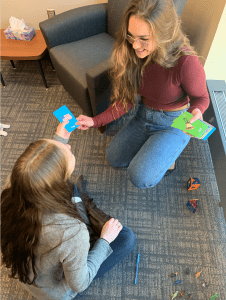Nov
2019
Embedded Teaching- Prompts
 In our last post, we outlined about the “create and wait” technique of embedded teaching. This is when you create a situation that would require a specific response from your child and wait for them to engage in the correct behavior. What happens if your child does not respond (stares at you blankly) or responds incorrectly? It may be necessary to remind, model, or prompt your child what they need to do! For example, you may give hints to your child about what you are expecting them to do.
In our last post, we outlined about the “create and wait” technique of embedded teaching. This is when you create a situation that would require a specific response from your child and wait for them to engage in the correct behavior. What happens if your child does not respond (stares at you blankly) or responds incorrectly? It may be necessary to remind, model, or prompt your child what they need to do! For example, you may give hints to your child about what you are expecting them to do.
For example, when you are the grocery store, you allow your child to pick a snack they like for the week. Perhaps, the goldfish are on the top shelf and they cannot reach it. Rather then grabbing the item, create and wait.Count to three in your head to see if they will ask for your help. If they don’t ask, try to prompt or give hints to what your child needs to do to get the gold fish. First, you point at the goldfish. Second, you may say, “What do we say when we need help from mom or dad?” Finally, you may prompt or remind your child to say, “Say ‘I need help, please.”
By prompting or reminding,this gives your child to understand and figure out what you want them to do. Often, you may notice your child needs lots of prompts.Over time, you will start to notice the number of hints, reminders, or prompts will decrease. You will notice your child is communicating more and relying less on your prompts. Remember with embedded teaching, the goal is to encourage more communication. At the Husky ABA clinic, graduate and faculty clinicians want to promote language by embedding earning opportunities at any given moment.
Check out our Facebook page for a demonstration of these techniques!
